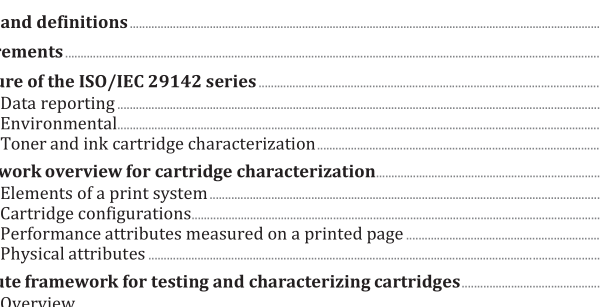ISO IEC 29142-1-2021 pdf download – Information technology — Print cartridge characterization — Part 1: General: terms, symbols, notations and cartridge characterization framework.
1 Scope This document establishes terms, symbols, notations and a framework for characterizing toner and ink cartridges used in printing devices that have a digital input printing path, including multi-function devices. This document is intended for equipment used in office environments. It primarily provides a foundation for measuring, evaluating, or specifying characteristics of such toner and ink cartridges. The terms, symbols, notations and framework established herein can be applied to such cartridges. The characterizations associated with the terms, symbols, notations, and framework established herein are specified throughout the ISO/IEC 29142 series. 2 Normative references The following documents are referred to in the text in such a way that some or all of their content constitutes requirements of this document. For dated references, only the edition cited applies. For undated references, the latest edition of the referenced document (including any amendments) applies. ISO 5-3, Photography and graphic technology — Density measurements — Part 3: Spectral conditions ISO 13655, Graphic technology — Spectral measurement and colorimetric computation for graphic arts images ISO/IEC 29142-2, Information technology — Print cartridge characterization — Part 2: Cartridge characterization data reporting 3 Terms and definitions For the purposes of this document, the following terms and definitions apply. ISO and IEC maintain terminological databases for use in standardization at the following addresses: — ISO Online browsing platform: available at https://www.iso .org/obp — IEC Electropedia: available at https://www.electropedia .org/ 3.1 all-in-one toner cartridge cartridge that includes at least: a toner (3.64) containment part (3.15), a photoreceptor part (3.47 ) and a developer part (3.20) Note 1 to entry: See Annex A for the term categorization.
3.11 cartridge life percent completion point point in the life of a cartridge computed as a percent of expected cartridge life ( 3.25 ) 3.12 cartridge set group of colourants and their assignment to one or more cartridges as defined by a printer manufacturer to be necessary and sufficient to produce the fully functional default colour renditions EXAMPLE 1 EXAMPLE 2 A printer (3.51) often has more than one fully functional cartridge set. Default colour renditions: printed black, red, green, blue, cyan, magenta, and yellow. 3.13 cartridge supplier cartridge marketer, manufacturer, remanufacturer (3.57 ), refiller ( 3.55 ), or distributor, being the party or parties responsible for marketing the cartridge and providing customer support for the cartridge 3.14 colour printer printer (3.51) with an operating part to apply ink (3.28) or toner (3.64) on a substrate (3.62), with a functionality to produce print output containing colours 3.15 containment part part containing the mechanism designed for materials intended for deposition on a substrate (3.62) 3.16 continuous attribute attribute which can take on any of a range of values 3.17 cross-systems attribute tolerance range CSATR range of actual attribute values for a cartridge-characterization attribute of a particular cartridge- characterization test method, determined from evaluation of exemplary systems to which the test method applies 3.18 customer report report, including a cartridge notification, and a cartridge-attribute checklist, with summary results of selected ISO/IEC 29142 cartridge-attribute characterization tests, presented according to a required format Note 1 to entry: The format is prescribed according to each ISO/IEC 29142 standardized or specified cartridge- characterization test ( 3.6 ) and is in conformance with ISO/IEC 29142-2. 3.19 deposition material material, ink (3.28) or toner (3.64), liquid or solid, colourant or non-colourant, that can be contained in a cartridge, and that is designed for deposition on a surface by means of a printing system 3.20 developer part physical mechanism, which is often a cartridge element (3.8), which functions to apply toner (3.64) particles to the latent image on the photoreceptor part (3.47 ) of an electrophotographic printing system 3.21 discrete attribute attribute which can take only a finite number of values within a range, such as an integer count
ISO IEC 29142-1:2021 pdf download – Information technology — Print cartridge characterization — Part 1: General: terms, symbols, notations and cartridge characterization framework






